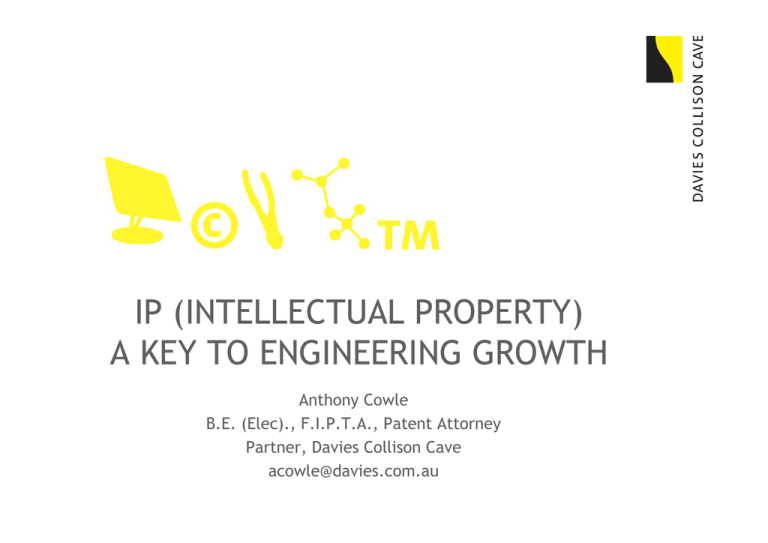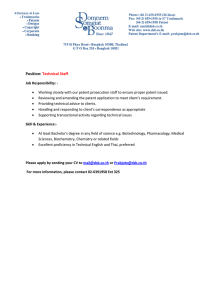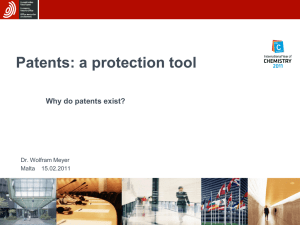ip (intellectual property) a key to engineering
advertisement

IP (INTELLECTUAL PROPERTY) A KEY TO ENGINEERING GROWTH Anthony Cowle B.E. (Elec)., F.I.P.T.A., Patent Attorney Partner, Davies Collison Cave acowle@davies.com.au IP - A KEY TO ENGINEERING GROWTH Small-to-Medium sized Enterprises (SMEs) – form the backbone of most economics – the driving force behind innovations and knowledge-driven economy – innovative capacity not always fully exploited – often under-utilise IP systems – general lack of awareness of IP IP - A KEY TO ENGINEERING GROWTH World Intellectual Property Office (WIPO) – administers the International Patent Application system – works with governments to develop policies and strategies Australian Government – SMEs need to compete in International marketplace in global economy – provides R&D grants, COMT, EMDG – reviewing IP legislation to focus on IP needs to SMEs IP - A KEY TO ENGINEERING GROWTH Registered Patent Attorneys – technical qualification – UTS qualifications – practical training IP - A KEY TO ENGINEERING GROWTH Australian Engineers – too modest? – under-estimate their capabilities and inventiveness? – need to recognise and protect their IP IP - A KEY TO ENGINEERING GROWTH Protection of IP will: – contribute to growth of Engineering businesses – improve competitiveness in International marketplace – increase profitability of Engineering firms – improve the profile of Engineers in the business/general community IP - A KEY TO ENGINEERING GROWTH – overview of IP rights – how to implement an IP policy in an Engineering business – other ways of Engineers using IP systems OVERVIEW OF INTELLECTUAL PROPERTY (IP) RIGHTS – Patents – Trade Marks – Registered Designs – Copyright – etc. All can provide an exclusive right to the creator/inventor All can be bought, sold, licensed EXAMPLES OF (IP) RIGHTS PATENTS – protect the way things work – cover products, methods or processes – exclusive right to exploit invention for term of Patent – requirements – – – novel (new) inventive (not obvious) useful – Standard Patent - 20 years - requires ‘inventive step’ – Innovation Patent - 8 years - requires ‘innovative step’ EXAMPLE OF PATENTABLE PRODUCTS/METHODS REGISTERED DESIGNS – protect the appearance of an article, i.e. shape or pattern – exclusive right to exploit article for term of Design – requirements – – new distinctive – term 10 years Note: Designs Act 2003 supersedes the Designs Act 1906 EXAMPLES OF REGISTERED DESIGNS TRADE MARKS – protect a name, logo, aspect of packaging, shape, scent, colour, sound, or any combination of these – must be distinctive - avoid descriptive words – Registered/Unregistered Trade Marks – term-indefinite (renewal - 10 year terms) – may represent the greatest asset of a company – proper use – – – – distinguish from other text indicate status by ® or TM identify as an adjective - e.g. Hoover Vacuum Cleaner don’t allow to become generic - e.g. escalator, esky, linoleum EXAMPLES OF REGISTERED TRADE MARKS COPYRIGHT – protects original literary, dramatic, musical, artistic works – includes brochures, instruction manuals, engineering drawings, architects plans, etc. – no registration - automatically exist upon creation – term - life of author plus 70 years OTHER IP RIGHTS – Domain Names - address on Internet – Common Law Rights - providing limited protection if no registered IP rights – Plant Breeders Rights – Circuit Layout Rights OBTAINING PATENT PROTECTION – see a Patent Attorney before disclosing to others to identify patentable inventions – file a Provisional application (provides 12 months International protection) – start commercialising invention – determine countries in which to protect invention, e.g. major markets OVERSEAS IP PROTECTION – Australia party to ‘Paris’ Convention – file overseas Patent applications or International PCT application - within 12 months – file overseas Designs applications / Trade Mark applications - within six months WHY SEEK IP RIGHTS? – overview of how/why the Patent system came into existence – the grant of a Patent is a ‘reward’ to the Patent owner for inventing and disclosing the invention – a ‘commercial tool’ which may be used to maximise the economic growth of a firm IMPORTANCE OF IP RIGHTS TO GROWTH – WIPO (World Intellectual Property Organisation) – administers PCT International Patent Application system – presently actively promoting importance of IP to developing countries – highlighting correlation : – strong IP system = economic growth of countries IMPORTANCE OF IP RIGHTS TO GROWTH – strong IP laws = strong economies – eg: US, Japan, Europe – recently strengthened IP laws = recently improved economies – eg: Singapore, South Korea – IP laws now being strengthened = increased growth now occurring – e.g. China, India IMPORTANCE OF IP RIGHTS TO GROWTH – Unfortunately, many Australian Engineers often overlook the fact that IP protection should be an integral part of a company’s business strategy, and therefore find it difficult to maintain competitiveness in the national/global economy – In recent years, Australian academic institutions have recognised that, by seeking Patent and other IP protection, for University developed inventions, they are able to licence or otherwise exploits rights for monetary returns, which in turn can fund growth and further development for the benefit of the institution IP AS A STRATEGIC TOOL – having IP rights, as such, does not grant business success – having a Patent does not guarantee an income stream – Patents merely prevent someone else from profiting from what has been invented by the Patent owner – the challenge is to turn the inventiveness and creativity into the sales of goods and services IP AS A STRATEGIC TOOL – sometimes it is prudent not to Patent – it may be better to keep it secret – it may be better to progress with fast product development and aggressive marketing making it impossible for competitors to copy in due time IP AS A STRATEGIC TOOL – for most engineering firms, considerable time and money is expended in R&D – in these cases, failure to obtain IP rights can be risky – opportunities to secure income are lost – resources for R&D are not recouped – Patents may be obtained by competitors to block commercial activities IP AS A STRATEGIC TOOL ∴ the key is to integrate Intellectual Property into a business strategy IP AS A STRATEGIC TOOL – sometimes ideas developed may not be aligned with key business strategies – then consider selling or out-licensing the IP rights for monetary returns IP AS A STRATEGIC TOOL – sometimes ideas developed by others are relevant to key business strategies – then consider buying or in-licensing the IP rights or partnering or forming a business alliance to commercialise innovations IMPLEMENTING AN IP POLICY – in order to operate effectively, the engineering manager must be thoroughly involved in promoting the importance of the company’s IP, and must be actively involved in disseminating information about IP – staff will only participate in company’s IP regime if they receive encouragement, direction and acknowledgement from management IMPLEMENTING AN IP POLICY – at commencement of employment, new staff should sign Confidentiality and Assignment Agreements, confirming that any and all IP developed during employment is assigned to company (this is Australian Law, but doing this reinforces the value and importance of IP to the company) – staff should receive regular educational seminars/workshops from the company’s IP advisers – staff should be taught the company’s policy and procedures for dealing with IP and how to identify and document new inventions – staff should be taught how to become aware of competitor’s IP and how it may be used to spur on further R&D within the company MOTIVATING ENGINEERING STAFF TO DISCLOSE IP INFORMATION – small gift of appreciation or monetary rewards – do this at relevant times – e.g. disclosure of invention, filing Patent application, grant of Patent, release of product to market, achieving volume of sales – promote publicly in organisation – e.g. emails, staff functions PROCESS FOR RECOGNISING AND DISCLOSING IP INFORMATION – educate engineering staff of Patent process so they understand how to recognise inventions and when their idea can be transposed into Patent claims – use Invention Disclosure (ID) form – helps inventor focus on commercial applications – helps management assess idea – helps Patent Attorney draft Patent application – records important dates - may be useful later – ID form triggers discussion of a strategic nature as to how to use invention in company’s strategy MONITOR COMPETITOR’S IP ACTIVITY – patent documentation is a valuable source of information often not divulged in other forms of literature – this information can be used to support and spur on R&D activities – despite the existence of this vast source of information, its use is surprisingly low, particularly amongst SMES – publication of Patents - 18 months from filing – inexpensive & easy (name, class, keywords), – www.uspto.gov – www.european-patent-office.org – www.ipaustralia.gov.au CONCLUSION – the commercial success of any business relies on the exclusivity of its products or services to ensure competitiveness in marketplace – it is imperative for engineering enterprises to have a proactive IP regime to assist in the commercial success of their business THANK YOU Contact: Anthony J Cowle Davies Collison Cave Level 10, 10 Barrack Street GPO Box 3876 Sydney New South Wales 2000 Phone: 02) 9262 2611 Fax: 02) 9262 1080 Email: acowle@davies.com.au Website: www.davies.com.au


